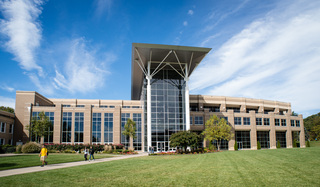 | Back to e-WV
| Back to e-WV
 The West Virginia Encyclopedia
The West Virginia Encyclopedia
 | Back to e-WV
| Back to e-WV
 The West Virginia Encyclopedia
The West Virginia Encyclopedia

Fairmont State University is situated on 90 acres a mile from downtown Fairmont. The college was formed in 1865, as West Virginia’s first private normal (or teacher-training) school. The state purchased the school in 1868, after providing $5,000 to assist in building construction the previous year.
The school was known variously as the Fairmont Branch Normal School, the Branch of the West Virginia Normal School at Fairmont, the Fairmont State Normal School, and the Fairmont Normal School. The cornerstone for its first building was laid August 15, 1867, at the corner of Adams and Quincy streets in the heart of town. The first class of students, consisting of 17 females and 13 males, occupied the new building in April 1869. In 1871, Hyre D. Clark of Buckhannon was the first graduate.
That same year, James G. Blair became the principal, the fifth person to head the school in six years. (The title was not changed from principal to president until Charles J. C. Bennett occupied the position, 1907–10.) Blair successfully urged the state to include secondary school classes in the curriculum of normal schools, because most students arrived insufficiently prepared for professional training. Blair continued as principal until his death December 23, 1878. His successor, M. Lizzie Dickey, was one of the first women to hold a high post in education in West Virginia. She continued as acting principal until 1882. Another woman, Nancy R. Cameron (Morrow), was acting principal, 1889–90.
By 1880, Fairmont had more students than any other normal school. On March 23, 1893, it moved to new quarters between Fairmont and Gaston avenues and Second and Third streets in South Fairmont. When enrollment outgrew that facility, the school procured 18.5 acres southwest of town, its present location, and moved there in January 1917. Soon after, America’s entry into World War I dropped the number of students to fewer than 400, but enrollment soared throughout the 1920s to a high of 1,856 by 1930–31. The student population never dropped below 1,200 during the Depression years.
The school shifted toward a college curriculum in 1912. In 1923, it was authorized to offer a four-year program but was to confine itself to training teachers. Renamed Fairmont State Teachers College in 1931, it became Fairmont State College in 1943 and a university in 2004.
World War II and its aftermath forced significant changes. Enrollment plunged as young men left for war. Eleven professors, a quarter of the faculty, joined them. By January 1944, only nine males registered for full-time study, out of 776 students in the 1944–45 academic year. Thirty-five Fairmont State College students and alumni died in military service. The GI Bill helped increase student population to 1,648 in 1946–47.
For three decades, Joseph Rosier (1915–45) presided over the college, the longest tenure of any president or principal. He guided Fairmont State through its move to Locust Avenue and the challenges of two world wars, a depression, and the enrollment boom of the 1920s. In 1945, Rosier passed the position to George W. Hand (1945–52). Hand’s successor, John W. Pence (1952–59) oversaw long-desired construction projects. With federal loans, Fairmont State was finally able to build a men’s dormitory, later named Pence Hall. Two wings were added to the women’s dorm, Morrow Hall, which had been in use since 1922. The cafeteria was expanded, a student center erected, and the administration building partially remodeled.
Construction continued in the 1960s under President Eaton K. Feaster. A new women’s dorm named North Hall was completed in 1964, and a fine arts building and a dining hall were finished in 1967. The football stadium, built by the Works Progress Administration during the 1930s and named in honor of President Rosier, was upgraded. Two private-sector projects, built just off campus in the 1960s, provided additional housing at a time when the student population doubled in five years.
After peaking at 1,798 in 1949–50, enrollment declined. Desegregation opened the campus to black students for the first time in 1954. Controversy came to the campus during the Red Scare of the 1950s, when art instructor Luella Raab Mundell’s contract was not renewed. Mundell sued State Board of Education member Thelma Brand Loudin for slander, claiming Loudin had accused her of being a communist and an atheist. Mundell lost in an emotional trial that divided the community and drew national attention. President Hand, who had refused to fire Mundell, lost his position in 1952.
In 1925, Alpha Psi Omega, an international collegiate honor society for drama students, was founded at Fairmont State College. The success of Alpha Psi Omega led to the founding of Thespians, a similar society for high school drama students.
Fairmont State Community and Technical College was established as part of Fairmont State in 1974. The community and technical college received separate accreditation in 2004. After the creation of the West Virginia Community and Technical College System, the Fairmont State Community and Technical College was renamed Pierpont Community and Technical College and became independent of Fairmont State University. After the separation of the community and technical college, Fairmont State University’s headcount enrollment remained strong and was recorded at 4,025 in fall 2015.
On January 1, 2018, Dr. Mirta Martin, originally from Cuba, became president of the university. In fall 2022, the school’s total enrollment was 3,498.
Fairmont State University website
Written by Gerald D. Swick
Turner, William P. A Centennial History of Fairmont State College. Fairmont State College, 1970.
Lough, Jo Ann. "Fairmont State College Occasional Papers Number 5, A Legacy: Cause and Effect." Fairmont Fairmont State College, 1994.